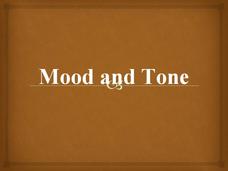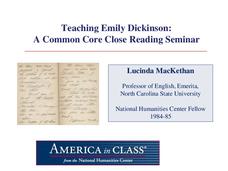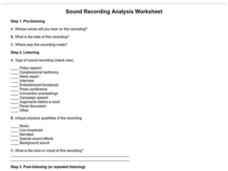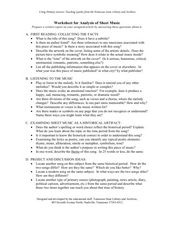Curated OER
Tone and Mood
How are mood and tone similar? Different? Help your readers understand the difference between the two with this helpful guide. On the first page, they read the definition for both tone and mood and identify words that are describe each....
E Reading Worksheets
Tone: Voice of the Speaker
Tone and mood are easy to use interchangeably—and yet they are very different elements of literature. Help middle schoolers discern between the way a speaker feels about his or her subject and the way the audience is meant to feel with a...
District 186 Springfield Public Schools
Tone, Mood, Theme, and Motif
It's all well and good when you're asked to identify a speaker's tone using his or her body language, facial expression, and pitch and emphasis. Identifying the tone of a written passage is another challenge entirely. Check out an...
Plainfield Public School District
Mood and Tone
"It was a dark and stormy night. Perfect for making Christmas cookies." Distinguishing between the mood of a piece and the tone can be tricky, but with the help of this presentation viewers quickly see and are able to identify the...
Curated OER
Mood
In this mood worksheet, students read a passage and define the theme, mood, and purpose of what they read. Students complete 3 questions.
Office of Migrant Education
Poetry: Form, Syllables, Mood, and Tone
Looking for a resource to introduce homeschoolers and other out-of-class learners to the elements of poetry? Check out this packet that defines and illustrates important poetry terms.
Macmillan Education
Understanding Poetry (Elementary)
Introduce young readers to poetry analysis with a worksheet that uses Emily Bronte's "Spellbound" to model how poets use word choice, the sounds of words, the repetition of words, and rhyming patterns to create the mood, tone, and...
Curated OER
Elements of Poetry
Prepare your learners to identify figurative language in poetry. Tips for reading poetry and what to look for are listed on these slides. Rhetorical devices are defined and plenty of examples are given.
Curated OER
Literary Techniques
Need to review literary terms/techniques with your class? The slides in this presentation define and give examples of 22 common literary terms. The PowerPoint could be used for AP test prep.
National Humanities Center
Teaching Emily Dickinson: A Common Core Close Reading Seminar
Three of Emily Dickinson's poems, "I like to see it," "Because I could not stop for Death," and "We grow accustomed to the Dark," provide instructors with an opportunity to model for class members how to use close reading strategies to...
Curated OER
the Baroque Period
Baroque styles in music, together with trends in tone, melody, and form are summarized in these slides. The points given are short and relevant. There is only a small amount of information, so this would be best as an accompaniment...
Curated OER
Literary Data Collection Chart
Here’s a matrix that could be used with any literary work. For each assigned passage, readers are asked to record information about characters, setting, vocabulary, literary devices, symbols, tone, mood, etc. In addition, they are asked...
K12 Reader
Adding Alliteration to Poetry
Alliteration can make the language of a poem flow. Add adjectives to several blanks in two poems to form alliterative phrases.
Curated OER
Sound Recording Analysis Worksheet
In this sound recording analysis learning exercise, students listen to a sound recording and analyze it in order to gain more information about the recording's subject.
Curated OER
Hillbilly Feud:Language Arts Game
English language learners or native elementary schoolers will enjoy practicing their parts of speech with this interactive grammar game. Set deep in the backwoods of Tennessee, the class splits in two to join either the Hartfields...
Curated OER
Ought to and Had better
In this ought to and had better worksheet, students identify usage in sentences. In this short answer and multiple choice worksheet, students write fourteen answers.
Curated OER
Elements of Fiction Study Guide
Class members must provide definitions for a list of literary terms. The resource could be used as a notebook reference sheet, as a review, or as a group work activity.
Curated OER
Worksheet for Analysis of a Motion Picture
In this primary source analysis instructional activity, students respond to 14 short answer questions that require them to analyze the motion picture of their choice.
Curated OER
Motion Picture Analysis Worksheet
In this motion picture analysis worksheet, students decipher what type of motion picture they viewed based on a complete list of criteria. Students then answer multiple questions based on their discoveries.
Curated OER
Writing Catchy Introductions
In this introductory paragraph worksheet, students learn techniques for writing an attention-catching introductory paragraph. Students then read several introductory paragraphs and determine which strategies were used.
Curated OER
Worksheet for Analysis of Sheet Music
In this primary source analysis worksheet, students respond to 20 short answer questions that require them to analyze sheet music of their choice.
Curated OER
Spectacular Speeches
In this language arts worksheet, students answer the 6 questions with the help of the Internet websites with the focus upon famous speeches.
Curated OER
Motion Picture Analysis Worksheet
In this motion picture worksheet, students analyze a motion picture and complete information for pre-viewing and then viewing the picture. Students also answer several post-viewing sections.
Austin Independent School District
Austin Independent School: Symbolism, Tone, and Mood [Pdf]
Click through this PDF slideshow to learn what a symbol is and how symbolism is used in literature. Then learn about the difference between tone and mood and see examples of each in a poem.
Other popular searches
- Mood and Tone
- Mood and Tone Worksheet
- Mood Tone
- Teaching Mood and Tone
- Author's Tone and Mood
- Analyzing Tone and Mood
- Tone and Mood Powerpoint
- Mood and Tone Activities
- Setting Tone and Mood
- Power Point Tone Mood
- Style Tone and Mood
- Identifying Mood and Tone

























![Austin Independent School: Symbolism, Tone, and Mood [Pdf] PPT Austin Independent School: Symbolism, Tone, and Mood [Pdf] PPT](https://d15y2dacu3jp90.cloudfront.net/images/attachment_defaults/resource/large/FPO-knovation.png)